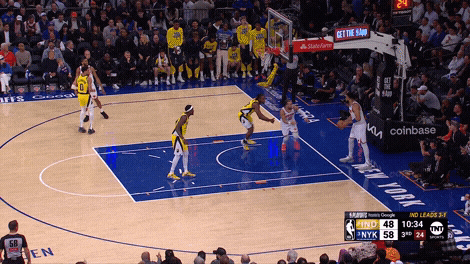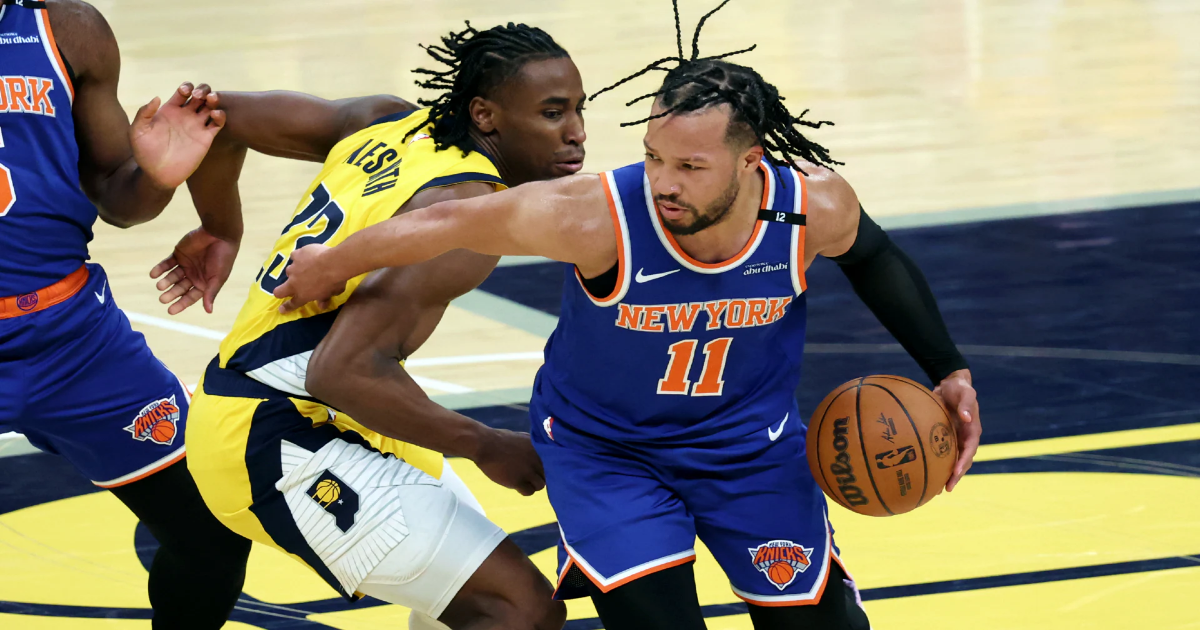
The Knicks earned a return trip to Indianapolis and another 48 minutes of basketball.
Facing elimination for the first time in Game 5 of the Eastern Conference Finals, the Knicks came up with their best defensive performance of the series (and maybe the entire season). They finally slowed down a Pacers offense that had scored more than 120 points per 100 possessions in 8 of its 14 games prior to Thursday.
Only 4% of teams facing a 3-1 deficit have come back to win a best-of-seven series in NBA history, but the Knicks have completed Step 1. Either of these teams can win on any given night, and two more of those given nights for the Knicks will put them in the NBA Finals.
The Pacers need just one, and their next opportunity is back at home in Game 6 on Saturday (8 ET, TNT).
Here are four things to watch as Indiana tries again to book a trip to Oklahoma City.
1. Can the Knicks defend like that again?
The Knicks’ defensive effort is apparent from the jump in Game 5, and they play on a string to stifle the Pacers throughout.
This series has been almost entirely about the Pacers’ end of the floor, where they’ve scored 126.1 points per 100 possessions in their three wins and just 101.0 per 100 in their two losses. The Knicks offense has been much more consistent over the five games.
Game 5, in which Indiana scored just 94 points on 97 possessions, was the Pacers’ worst offensive game of these playoffs:
- The Knicks didn’t make them work late in the shot clock nearly as much as they did in Game 3. According to Second Spectrum tracking, 19% of the Pacers’ shots came in the last seven seconds of the clock, a rate slightly lower than their rate through the first four games.
- The Pacers moved the ball more than they had in any other game in this series. They registered 384 passes per 24 minutes of possession, a rate much higher than their previous high of 335 per 24 (Game 4).
The extra ball movement could be a result of the Pacers not gaining advantages with their initial actions.
Midway through the second quarter, Aaron Nesmith rolled into space after setting a screen for Tyrese Haliburton, but Karl-Anthony Towns rotated and erased the advantage. Jalen Brunson then switched onto Towns’ man (Myles Turner), forcing to the Pacers to try again:

The Knicks gave more effort and made fewer mistakes. Their switching and rotations were on point. The Pacers could have been better offensively, but their shooting might also be coming back to earth after registering what was the highest eFG% in NBA playoff history over their first 12 games (through Game 2 of this series).
If the Knicks can bring another defensive effort like that – or the Pacers can’t make open shots – on Saturday, we could see another Game 7 at Madison Square Garden.
2. Can the Pacers stop Brunson or Towns?
Jalen Brunson scores 14 of his 32 points in the 1st quarter and New York never trails Indiana in a must-win Game 5 at MSG.
The Pacers’ offensive efficiency through the first four games masked the fact that they weren’t getting a ton of stops on the other end. Through Game 5, the Knicks have scored 117.8 points per 100 possessions, 7.1 more than they scored through the first two rounds. And that’s with OG Anunoby and Mikal Bridges shooting a combined 4-for-24 (17%) on corner 3-pointers.
Indiana has had a particular problem with Brunson and Towns. They’ve been the two leading scorers in this series, combining to average 58.4 points on a true shooting percentage of 64.6%, up from 49.4 on 57.6% through the first two rounds.
Nesmith had some success guarding Brunson through the first four games, but Brunson shot 5-for-5 against him in Game 5. The Knicks’ star was aggressive early, both early in the game and early in the shot clock.
Early in the third quarter, Nesmith pressured Brunson full-court, and Brunson turned that pressure into an advantage for himself:

Game 5 was also the first time that Towns was defended more by Pascal Siakam than by Turner. Neither has been a good matchup for the Pacers, but the Siakam matchup allows Towns to play bigger, one reason why the Knicks had a 26-point advantage in the paint (60-34) on Thursday.

The Pacers have had some success when sending a double-team at Brunson or Towns, but according to Second Spectrum, the Knicks scored 29 points on 19 chances (1.53 per) in Game 5 when either of their stars were doubled.
3. The possession game always matters
Charles Barkley thinks the Pacers ‘played satisfied’ instead of pushing to eliminate the Knicks, and it cost them Game 5 in New York.
The possession game was pretty even in each of the first four games. The Pacers committed fewer turnovers, while the Knicks grabbed more offensive rebounds. Prior to Thursday, shooting opportunities (field goal attempts or trips to the line) were plus-4 in favor of Indiana.
But in Game 5, New York got 12 more shooting opportunities than the Pacers. That was their best differential of the playoffs, with the Knicks again winning the battle of the boards, while also committing fewer turnovers than the Pacers for the first time in the series.
The bigger difference (as it’s been overall) was on the Pacers’ end of the floor. Their 20 turnovers marked a postseason high and helped the Knicks score 24 transition points, an N.Y. best for the series.
The Pacers have gotten higher-quality shots in four of the five games, but can’t take far fewer shots like they did in Game 5. The possession game matters and it’s critical for both teams to take care of the ball and rebound.
4. Does home-court advantage matter?
The Pacers have won two of the three games in New York and also clobbered the Knicks in Game 7 at Madison Square Garden last year. A loss in Game 6 certainly wouldn’t spell their doom. Either team could win any game in this series and road teams have won nine of the last 14 Game 7s overall.
But they’d surely love to take care of business at home on Saturday. Indiana hasn’t lost two straight games since March 10, and they don’t want that streak to end on the biggest stage most of these players have been on. Another loss would give the Knicks life and confidence.
The Knicks, like the Pacers, are 6-2 on the road in these playoffs, though they’ve been better, statistically, at home. All six of those wins have been by six points or fewer, with the Knicks holding their opponents to 46 points on 59 clutch possessions (0.78 per) over those six games.
Another clutch situation could be in the cards on Saturday. Every possession matters.
* * *
John Schuhmann is a senior stats analyst for NBA.com. You can e-mail him here, find his archive here and follow him on X.
The views on this page do not necessarily reflect the views of the NBA, its clubs or Warner Bros. Discovery.
